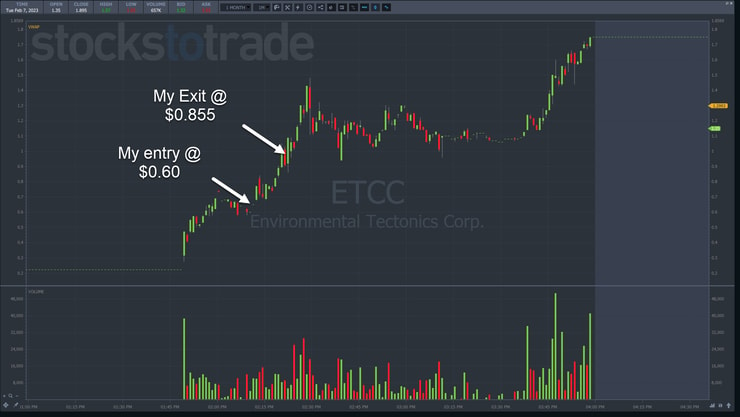We all want to catch that big runner…picking off the bottom tick and riding it to glory.
In reality, folks who try to do this lose their shirts.
They shoot for perfection and land in failure.
Instead, I teach my students to take predictable, repeatable setups using time-tested blueprints like my 7-Step Penny Stock Framework.
For me, it’s more about trading consistently than swinging for the fences.
That’s why I focus so much on risk management.
A lot of people think I’m a coward for the way I trade.
Honestly, I’ll embrace that title.
Because if you don’t survive, you’ll never thrive.
That’s why my #1 rule is to cut losses quickly.
However, that also applies to taking profits.
You see, I know what I’m good at and what I’m not.
My comfort zone is picking up 5%-10% gains over and over like a casino, not squeezing all the juice I can out of one stock.
This might surprise you, considering I’ve traded for over two decades, made millions in the market, and helped 32 of my Millionaire Challenge students become millionaire traders in their own right.
But let me show you why I prefer to trade conservatively and some alternative methods.
Then, you can choose the risk management that’s right for you.
A look at Environmental Tectonics Corp. (OTC: ETCC)

Late Tuesday afternoon, our Breaking News team alerted me to a catalyst in ETCC.
I prefer to take trades near the open. However, a solid news catalyst on the right stock can create an opportunity in the afternoon.
But here’s the thing…
The later in the day these trades form, the riskier they become.
Sure, a runner can push all the way into the close.
It can also top out and crash.
This was my trade execution in ETCC.
Let’s start with my entry.
I waited for a pullback dip before I entered the trade rather than buying as it ran higher.
This is a conservative way to trade for two reasons.
First, it ensures you entry isn’t at the high of the day.
Second, buying into a pullback that consolidates gives you something to trade against.
If you look at the small range formed just before my entry, you can see the low is a touch below $0.60.
So, my risk is about as tiny as it gets.
However, it’s relative to the total move made by the stock.
$0.01-$0.02 could be huge.
But in this case, that’s negligible compared to the $0.40 move the stock already made.
Now, let’s turn to exit.
When I took the trade off, I did so based on two key factors:
- The level 2 data indicated the stock was losing momentum
- The price action started to reverse
It turns out that it wasn’t the top.
However, I want you to think about this in mathematical terms.
My total risk was about $0.01, but let’s be generous and say it was $0.05.
When I’m up $0.155, I’ve earned more than 3x my risk.
In fact, that risk reward relationship is so skewed towards my reward that I’d only need a 25% win-rate to break even.
From a pure profit perspective, it simply makes sense for me to trade scared.
Now, you may not hit a 75% win-rate starting out.
But if you take trades with the right risk/reward relationship and adhere to your stops, you could win 33% of the time and still turn a profit.
Maximizing alternatives

Some traders like to scale out of trades as they hit profit targets.
This lets them capture more profit potential on big runners.
If this appeals to you, I would keep things simple.
Take more than half the trade off at your first profit target.
Then, set a stop loss for breakeven on the remainder.
As the stock rises, continue to scale out, cutting your remaining position in half each time.
And each time you exit, raise your stop loss to the last profit target level.
This method, or similar, ensures you protect your profits while leaving an opportunity to maximize your potential.
People may call me a coward because I don’t swing for the fences with every trade.
But my trading account is full and grows consistently.
For me, that’s plenty.
—Tim


Leave a reply